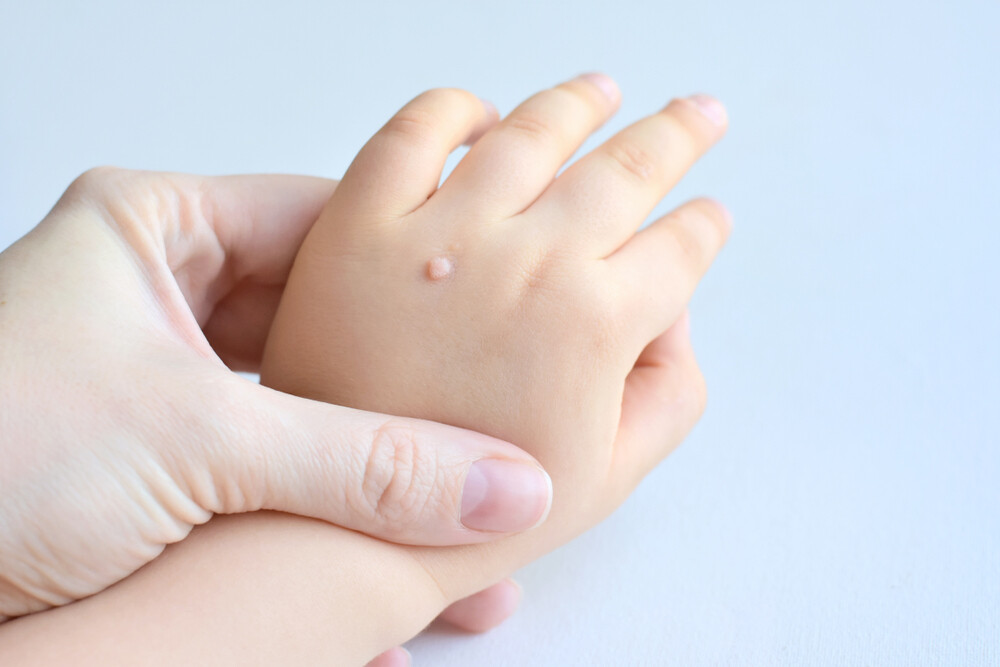Warts in children – a tiresome topic. But there is still no reason to panic. The benign growths are not dangerous for children. Nevertheless, they should be observed and removed if necessary, because warts are highly infectious.
Warts are particularly common in school children. At this age, warts affect about three in ten children. The reasons are obvious: children have much more skin contact with each other. Whether in the swimming pool, the daycare centre, during school sports, everywhere children come into contact with each other. Ideal conditions for the viruses to spread further. At the same time, the child’s immune system is not yet fully developed and the skin is more sensitive. Dry skin in particular is susceptible to warts, as the skin barrier is disturbed. This means that the viruses that cause warts are not fended off as effectively as in adults.
These are the most common warts in children
There are three main types common among children: vulgar warts, plantar warts or dell warts.
Vulgar warts
- Account for about 70 percent of cases
- Appearance: scaly, pea-sized bumps, similar to a cauliflower. They usually form on fingers, hands, soles of the feet or face.
- Pathogen: Human papilloma viruses (HPV)
- Transmission: by smear infection, i.e. through physical contact
Plantar warts
- May cause pain when walking
- Appearance: flat to slightly convex and recognisable as a circle with dark dots. They grow on the soles of the feet, where they form long, pointed stems that penetrate deep into the skin like thorns
- Pathogen: Human papilloma viruses (HPV)
- Transmission: by smear infection, i.e. through physical contact
Dell Warts
- Appearance: resemble pimples, are skin-coloured to slightly reddish and have a dent in the middle.
- They often cover entire areas of skin on the face, neck, arms and legs.
- Pathogen: Dell’s warts are caused by a harmless pox virus.
- Transmission: The fluid in mollusk warts contains highly contagious viruses, so these warts are not expressed at all.
How to treat warts in children
First of all: Keep calm. As long as the wart does not bother you, you do not have to do anything. So first of all you can wait and see whether the annoying wart disappears by itself. This is the case with two thirds of warts in children. However, it can take between three months and two years. Not for the impatient. For those who do not want to wait, there are various treatment options available:
- special tinctures and patches with salicylic acid from the pharmacy. These soften the surface of the wart, so that the horny layer can be gradually removed.
- Icing sprays from the pharmacy also help. Usually two to three applications of the liquid gas mixture are sufficient to remove warts in children.
- In addition, the doctor may prescribe remedies containing a virus-killing agent.
- If the wart is very persistent or hurts when walking, the doctor can ice it, laser it or remove it surgically.
Preventing warts in children: What you can do
- Wearing flip-flops: Since warts in children are often brought in from the swimming pool, wearing flip-flops is an important measure to avoid unpleasant souvenirs.
- Drying off well: After bathing, dry your feet thoroughly, including the spaces between your toes.
- Washing: Wash your hands regularly with soap.
- Hands off: If a wart has nevertheless grown, do not touch it and do not push it around.
- Showering: If someone in the family has caught a plantar wart, better not bathe or shower together.
- In the washing machine: Always wash towels, socks and stockings at 60 degrees so that not all family members get infected.

